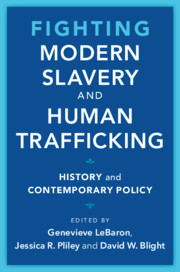Book contents
- Fighting Modern Slavery and Human Trafficking
- Slaveries since Emancipation
- Fighting Modern Slavery and Human Trafficking
- Copyright page
- Contents
- Figures
- Tables
- Contributors
- Preface
- Acknowledgments
- Abbreviations
- 1 Introduction
- 2 Counting Modern Slaves
- 3 Working Analogies
- 4 Free Soil, Free Produce, Free Communities
- 5 Ambivalent Abolitionist Legacies
- 6 Mexico’s New Slavery
- 7 Undermining Labor Power
- 8 A Market in Deception? Ethically Certifying Exploitative Supply Chains
- 9 Preventing Human Trafficking
- 10 Integrated and Indivisible
- Afterword If There Is No Struggle, There Is No Progress
- Index
9 - Preventing Human Trafficking
The Role of the IOM and the UN Global Compact on Migration
Published online by Cambridge University Press: 18 June 2021
- Fighting Modern Slavery and Human Trafficking
- Slaveries since Emancipation
- Fighting Modern Slavery and Human Trafficking
- Copyright page
- Contents
- Figures
- Tables
- Contributors
- Preface
- Acknowledgments
- Abbreviations
- 1 Introduction
- 2 Counting Modern Slaves
- 3 Working Analogies
- 4 Free Soil, Free Produce, Free Communities
- 5 Ambivalent Abolitionist Legacies
- 6 Mexico’s New Slavery
- 7 Undermining Labor Power
- 8 A Market in Deception? Ethically Certifying Exploitative Supply Chains
- 9 Preventing Human Trafficking
- 10 Integrated and Indivisible
- Afterword If There Is No Struggle, There Is No Progress
- Index
Summary
Since the international community adopted the UN Trafficking Protocol nearly two decades ago, our approach to the problem of human trafficking has shifted significantly. With too few traffickers prosecuted and too few victims protected, there is growing recognition of the need for more robust efforts to prevent trafficking in the first instance. Trafficking is not simply the product of deviant, criminal behavior that once rooted out, can be easily eliminated. Also to blame are deeply embedded societal structures that facilitate, and even reward, exploitation – in particular, weak labor and migration frameworks that perpetuate precarity for migrant workers in their search for economic opportunities. Because worker exploitation and trafficking differ in degree, not in kind, addressing worker exploitation more broadly can help prevent the abuses from escalating into trafficking. This Chapter explores how emerging global governance over labor migration – with the recently-adopted UN Global Compact for Safe, Orderly, and Regular Migration and the now-elevated role of the International Organization for Migration – could play a role in preventing human trafficking.
Keywords
- Type
- Chapter
- Information
- Fighting Modern Slavery and Human TraffickingHistory and Contemporary Policy, pp. 179 - 202Publisher: Cambridge University PressPrint publication year: 2021
- 2
- Cited by



